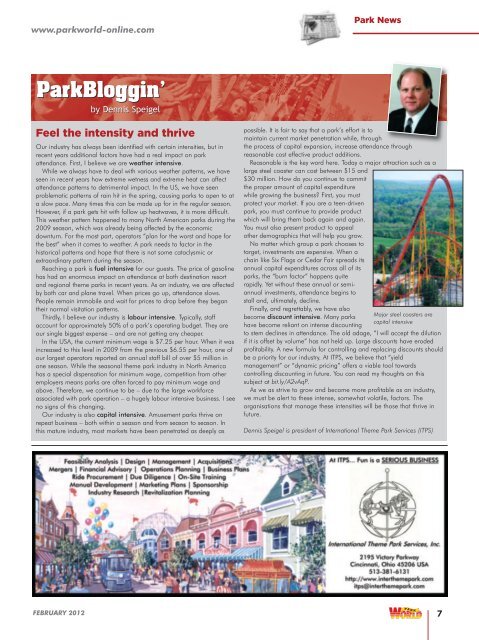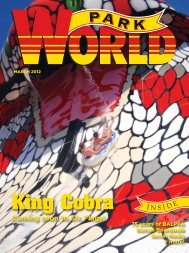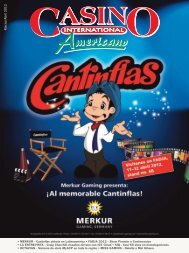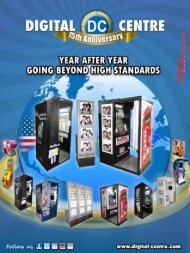Park Newswww.parkworld-online.comParkHoppin’with Paul RubenWindy WonderlandDid you know that most Americans don’t have passports? Onlyabout 6% do. That’s probably a good thing, so we don’t visit andannoy the rest of the world more than we already do. But as aresult, the traffic line on the bridge into Canada, where we nowneed passports to enter, was much shorter than in past years.Actually, we don’t need passports to enter Canada, but we needthem to return to the US and since the Canadians don’t want usstranded after our money has been spent there, they ask to see ourpassports when we arrive.I was on my way to Canada’s Wonderland to ride and report onits <strong>new</strong> attraction last season, WindSeeker. It’s a towering chairswing by Mondial. Four were installed at Cedar Fair-owned parks in2011, with a further two to follow this coming season.Canada’s Wonderland was my closest. Located outside Toronto, itis the fastest growing park in the CedarFair chain. Toronto’s population isexploding, thanks primarily toimmigration, and the park’s attendanceis a beneficiary. Under vice-presidentand general manager Norm Pirtovshek’sguidance, it continues to add more highcapacity rides. WindSeeker will befollowed this year by the 306ft-tallLeviathan coaster.On WindSeeker, as many as 64 riderssit in open two-passenger swings withtheir feet dangling in the breeze. Theswings rotate around the 30-storeycentre column as you slowly ascend thetower. At the top, you are treated todramatic views of the surroundinglandscape as you take a 60-secondflight at a 45-degree angle at a speedof 25 to 30 mph (40 to 50kmh).I climbed aboard, floated upwards, and began to circle as in thephoto above. It felt as if I was soaring quietly in a glider, except thesame damn scene came around every seven and a half seconds. Itwas a hot day, but 300ft (91m) in the air, with the wind brushingyour face, it felt cool.WindSeeker is promoted as a thrill ride, but unless you have afear of heights to generate an adrenaline rush, it is not. Rather, itwas smooth with none of the bumps and lurching turns of many ofthe rides below. It was serene. I could have remained aloft all day ifthey had let me. I could see and identify the landmark rides in thepark. I marvelled at the ever expanding rows of nearby housingwhere, when the park first opened 30 years earlier, there had beenonly cow pastures. To the south I could see downtown Toronto, LakeOntario beyond, and even the US. What a view!Mondial offers several shorter and lower capacity versions, and ofcourse we mustn’t forget the similar rides offered by othermanufacturers, notably Funtime with its pioneering Star Flyer. It gotme thinking. If the classic chair swing can be rejuvenated by lifting itskyward, are there other flat rides that would benefit from the towertreatment? Like riding prone on your stomach, arms outstretched,alongside the gulls? Or on twirling tea cups? The mind races. Andthen gets dizzy ...ewww.A Lotte water!New waterpark planned in KoreaSouth Korea’s Lotte Group is to build a<strong>new</strong> waterpark in Kimhae near Busan. Theproject will include a US$22 millionpackage of attractions from WhiteWater,the largest ever order for the Canadiansupplier. Dubbed the Lotte WorldWaterpark, completion is anticipated forMay 2013.Included will be WhiteWater’s <strong>new</strong>Family Rattler and Family Python, twoA rendering for the waterparkMEGAtube rides, a Family Boomerango,AquaLoop, Abyss, 8-Lane Whizzard, Family Raft Ride, Dueling Master Blasters,speed slide and body slides. Also planned is a 35-metre pneumatic surf wavepool, an 18-metre indoor family wave pool, a double FlowRider and twoPolynesian-themed AquaPlay multi-level play structures."WhiteWater is thrilled to have been chosen as the supplier and manufacturerfor Lotte World Waterpark,” confirms the company’s CEO, Geoff Chutter. “Thisproject will be a wonderful showcase of WhiteWater's signature attractions and weare proud to be part of such an industry leading project."*The Lotte Group has chosen International Theme Park Services (ITPS) to work onan analysis and strategic planning for its original Lotte World indoor/outdoor themepark in Seoul. “We are enormously happy that the Lotte World team has onceagain chosen ITPS to assistthem in their investment andgrowth into the future,” saysITPS president DennisSpeigel. “We were part ofthe original conceptdevelopment team for LotteWorld, providing feasibilityanalysis, pre-openingoperations planning, stafftraining and on-sitemanagement for threeLotte World in Seoulyears.”Wet ’n’ Tame!Well known for its high thrill waterslides and multi-person attractions, Wet ‘n’Wild Orlando is to add a family focused attraction for this coming summer.Covering an area of one acre (400,000 square metres), the sandcastlethemedwater playground will be the largest of its kind in Florida.The interactive attraction will be built on the site of Wet ‘n’ Wild’s currentkids park, where it will span two pools, standing 60ft (20m) in height, spreadover two levels. Featured will be 17 slides and over 100 soakers, jets, waterfallsand water cannons.Recognised by theWorld WaterparkAssociation as theworld’s first waterpark,Wet ‘n’ Wild Orlandowas founded in 1977by Sea Worldentrepreneur GeorgeMillay. Now owned byNBCUniversal, todayit features over 15themed attractions.6FEBRUARY 2012
www.parkworld-online.comPark NewsParkBloggin’by Dennis SpeigelFeel the intensity and thriveOur industry has always been identified with certain intensities, but inrecent years additional factors have had a real impact on parkattendance. First, I believe we are weather intensive.While we always have to deal with various weather patterns, we haveseen in recent years how extreme wetness and extreme heat can affectattendance patterns to detrimental impact. In the US, we have seenproblematic patterns of rain hit in the spring, causing parks to open to ata slow pace. Many times this can be made up for in the regular season.However, if a park gets hit with follow up heatwaves, it is more difficult.This weather pattern happened to many North American parks during the2009 season, which was already being affected by the economicdownturn. For the most part, operators “plan for the worst and hope forthe best” when it comes to weather. A park needs to factor in thehistorical patterns and hope that there is not some cataclysmic orextraordinary pattern during the season.Reaching a park is fuel intensive for our guests. The price of gasolinehas had an enormous impact on attendance at both destination resortand regional theme parks in recent years. As an industry, we are affectedby both car and plane travel. When prices go up, attendance slows.People remain immobile and wait for prices to drop before they begantheir normal visitation patterns.Thirdly, I believe our industry is labour intensive. Typically, staffaccount for approximately 50% of a park’s operating budget. They areour single biggest expense – and are not getting any cheaper.In the USA, the current minimum wage is $7.25 per hour. When it wasincreased to this level in 2009 from the previous $6.55 per hour, one ofour largest operators reported an annual staff bill of over $5 million inone season. While the seasonal theme park industry in North Americahas a special dispensation for minimum wage, competition from otheremployers means parks are often forced to pay minimum wage andabove. Therefore, we continue to be – due to the large workforceassociated with park operation – a hugely labour intensive business. I seeno signs of this changing.Our industry is also capital intensive. Amusement parks thrive onrepeat business – both within a season and from season to season. Inthis mature industry, most markets have been penetrated as deeply aspossible. It is fair to say that a park’s effort is tomaintain current market penetration while, throughthe process of capital expansion, increase attendance throughreasonable cost effective product additions.Reasonable is the key word here. Today a major attraction such as alarge steel coaster can cost between $15 and$30 million. How do you continue to committhe proper amount of capital expenditurewhile growing the business? First, you mustprotect your market. If you are a teen-drivenpark, you must continue to provide productwhich will bring them back again and again.You must also present product to appealother demographics that will help you grow.No matter which group a park chooses totarget, investments are expensive. When achain like Six Flags or Cedar Fair spreads itsannual capital expenditures across all of itsparks, the “burn factor” happens quiterapidly. Yet without these annual or semiannualinvestments, attendance begins tostall and, ultimately, decline.Finally, and regrettably, we have alsobecome discount intensive. Many parkshave become reliant on intense discountingMajor steel coasters arecapital intensiveto stem declines in attendance. The old adage, “I will accept the dilutionif it is offset by volume” has not held up. Large discounts have erodedprofitability. A <strong>new</strong> formula for controlling and replacing discounts shouldbe a priority for our industry. At ITPS, we believe that “yieldmanagement” or “dynamic pricing” offers a viable tool towardscontrolling discounting in future. You can read my thoughts on thissubject at bit.ly/A2vAqP.As we as strive to grow and become more profitable as an industry,we must be alert to these intense, somewhat volatile, factors. Theorganisations that manage these intensities will be those that thrive infuture.Dennis Speigel is president of International Theme Park Services (ITPS)FEBRUARY 20127
















